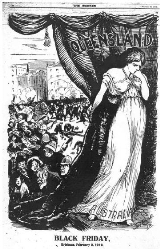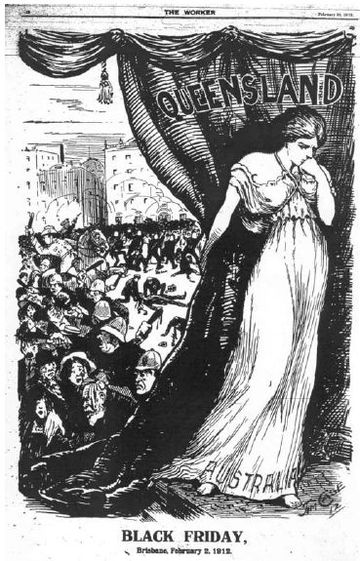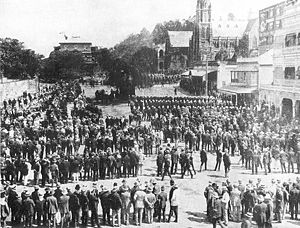
1912 Brisbane General Strike
Encyclopedia

Queensland
Queensland is a state of Australia, occupying the north-eastern section of the mainland continent. It is bordered by the Northern Territory, South Australia and New South Wales to the west, south-west and south respectively. To the east, Queensland is bordered by the Coral Sea and Pacific Ocean...
, Australia
Australia
Australia , officially the Commonwealth of Australia, is a country in the Southern Hemisphere comprising the mainland of the Australian continent, the island of Tasmania, and numerous smaller islands in the Indian and Pacific Oceans. It is the world's sixth-largest country by total area...
, began when members of the Australian Tramway Employees Association
Australian Rail Tram and Bus Industry Union
The Australian Rail Tram & Bus Industry Union , formerly known as the Public Transport Union or PTU, was formed on 1 March 1993, through the amalgamation of the Australian Railways Union, the Australian Federated Union of Locomotive Enginemen, the Australian Tramway & Motor Omnibus Employees'...
were dismissed when they wore union badges to work on 18 January 1912. They then marched to Brisbane Trades Hall
Brisbane Trades Hall
The Brisbane Trades Hall is the Trades Hall building in the Australian city of Brisbane. It is used by the Queensland trade union movement for meetings, offices, social and educational events, and is the location of the Trades and Labour Council, now known as the Queensland Council of Unions...
where a meeting was held, with a mass protest meeting of 10,000 people held that night in Market Square (later known as King George Square
King George Square, Brisbane
King George Square is a public square, located between Adelaide Street and Ann Street , in Brisbane, Queensland, Australia. Adjacent to King George Square is Brisbane City Hall...
).
General Strike
The Brisbane tramways were owned by the General Electric Company of the United KingdomUnited Kingdom
The United Kingdom of Great Britain and Northern IrelandIn the United Kingdom and Dependencies, other languages have been officially recognised as legitimate autochthonous languages under the European Charter for Regional or Minority Languages...
. Despite this they were managed by Joseph Stillman Badger, an American, who refused to negotiate with the Queensland peak union body
Queensland Council of Unions
The Queensland Council of Unions is a representative body of Trade union organisations, known as a Labour council, in the State of Queensland, Australia...
, then known as the Australian Labour Federation. After this rebuff a meeting of delegates from forty-three Brisbane
Brisbane
Brisbane is the capital and most populous city in the Australian state of Queensland and the third most populous city in Australia. Brisbane's metropolitan area has a population of over 2 million, and the South East Queensland urban conurbation, centred around Brisbane, encompasses a population of...
based Trade Unions formed the Combined Unions Committee and appointed a General Strike Committee. The trade union
Trade union
A trade union, trades union or labor union is an organization of workers that have banded together to achieve common goals such as better working conditions. The trade union, through its leadership, bargains with the employer on behalf of union members and negotiates labour contracts with...
ists of Brisbane went out on a general strike
General strike
A general strike is a strike action by a critical mass of the labour force in a city, region, or country. While a general strike can be for political goals, economic goals, or both, it tends to gain its momentum from the ideological or class sympathies of the participants...
on 30 January 1912, not just for the right to wear a badge but for the basic right to join a union.
Within a few days the Strike Committee became an alternative government. No work could be done in Brisbane without a special permit from the Strike Committee. The committee organised 500 vigilance officers to keep order among strikers and set up its own Ambulance Brigade. Government departments and private employers needed the Strike Committee's permission to carry out any work. The Strike Committee issued strike coupons that were honoured by various firms. Red ribbons were generally worn as a mark of solidarity, not only by people but also on pet dogs and horses pulling carts. Daily processions and public rallies were held to keep strikers occupied.
On the second day of the strike over 25,000 workers marched from the Brisbane Trades Hall
Brisbane Trades Hall
The Brisbane Trades Hall is the Trades Hall building in the Australian city of Brisbane. It is used by the Queensland trade union movement for meetings, offices, social and educational events, and is the location of the Trades and Labour Council, now known as the Queensland Council of Unions...
to Fortitude Valley and back with over 50,000 supporters watching from the sidelines. The procession was described as being led by Labor parliamentarians, with the procession being eight abreast and two miles (3 km) long, with a contingent of 600 women. The strike spread throughout Queensland with many regional centres organising processions through their towns. The strike committee regularly issued an official Strike Bulletin to counter the expected anti-union bias in mainstream newspapers.
It was only when the strike spread to the railways that the Queensland government became concerned about the situation. At this juncture it banned processions, swore in special constables and issued bayonets to its police force. Commonwealth military officers and spare-time troops volunteered as special constables, and many of the specials wore their commonwealth uniforms into action.
Black Friday

Despite the refusal of a permit, a crowd estimated at 15,000 turned up in Market Square. Police and Specials attacked crowds in Market Street under the direction of Cahill, who shouted, "Give it to them, lads! Into them." Meanwhile Emma Miller
Emma Miller
Emma Miller was a pioneer trade union organiser, suffragist, and founder of the Australian Labor Party in Brisbane, Queensland, Australia.-Early life:...
, a pioneer trade unionist and suffragist, led a group of women and girls to parliament house and, while returning along Queen Street, were batoned and arrested by a large contingent of foot and mounted police. Emma Miller, a frail woman in her 70s barely weighing 35 kilograms, stood her ground, pulled out her hat pin and stabbed the rump of the Police Commissioner's horse. The horse reared and threw off the Police Commissioner, giving him an injury resulting in a limp for the rest of his life. There is some debate that Miller's hatpin stabbed Cahill in the leg.
The riding down and batoning of peaceful people, many of them being elderly and women and children on the footpath, was widely condemned, not only in union papers such as the Worker, but also in the more conservative papers such as Truth. It was initially called Baton Friday, but later came to be popularly known as Black Friday.
Conservative Queensland Premier Digby Denham
Digby Denham
Digby Frank Denham was an Australian politician, businessman and leading Queensland Orangeman. He was a member of the Queensland Legislative Assembly from 1902 until 1915 representing the seat of Oxley, and was Premier of Queensland from 7 February 1911 to 1 June 1915...
, viewed the strike committee as an opposing alternate administration and said there were "not going to be two governments" and opposed all further permits for processions. When he attempted to enlist support of the Federal Government in the use of the military, he was rebuffed by the Labor Prime Minister, Andrew Fisher
Andrew Fisher
Andrew Fisher was an Australian politician who served as the fifth Prime Minister on three separate occasions. Fisher's 1910-13 Labor ministry completed a vast legislative programme which made him, along with Protectionist Alfred Deakin, the founder of the statutory structure of the new nation...
, member for the Queensland seat of Gympie. Fisher had also received a request for military support from the Combined strike committee, but declined this offer preferring to send a monetary donation in support of the strike.
Aftermath
Justice H.B. Higgins in the Federal Arbitration Court ruled that the precipitating event was a lockout rather than a strike, and that the regulation refusing tramwaymen the right to wear their union badges on duty was both unauthorised and unreasonable. Higgins could not intervene in restoration of jobs.When the Employers Federation agreed on the 6 March 1912 that there would be no victimisation of strikers the strike officially ended.
The savagery of the baton charges by the Queensland Police
Queensland Police
The Queensland Police Service is the law enforcement agency responsible for policing the Australian state of Queensland. In 1990, the Queensland Police Force was officially renamed the Queensland Police Service and the old motto of "Firmness with Courtesy" was changed to "With Honour We Serve"...
and specials on Black Friday created a bitterness and hatred of the police which would last for several decades. The strike reinforced solidarity and collective identity of the Australian labour movement
Australian labour movement
The Australian labour movement has its origins in the early 19th century and includes both trade unions and political activity. At its broadest, the movement can be defined as encompassing the industrial wing, the unions in Australia, and the political wing, the Australian Labor Party and minor...
in Queensland. The Denham government immediately won an ensuing election on a "Law and Order" platform and passed the Industrial Peace Act of 1912 ushering in compulsory arbitration specifically to deter strikes in essential services.
Employees of the tramway company who had struck were sacked. The tramway company refused to ever re-hire these workers. When the tram system was acquired by the Queensland Government in 1922 the sacked workers were reinstated. Interestingly, badges on uniforms - the cause of the strike - were forbidden even when the tram system (and later bus system) was under government and later Brisbane City Council control and were to remain forbidden until 1980.
In the aftermath of the strike three years later there was an electoral swing to Labor
Australian Labor Party
The Australian Labor Party is an Australian political party. It has been the governing party of the Commonwealth of Australia since the 2007 federal election. Julia Gillard is the party's federal parliamentary leader and Prime Minister of Australia...
all over Queensland, and the second Queensland Labor Government was elected in 1915, led by T. J. Ryan
T. J. Ryan
Thomas Joseph "T.J." Ryan was Premier of Queensland, Australia from May 1915 until October 1919 when he resigned to enter Federal politics.-Early life:Thomas Joseph Ryan was born at Port Fairy, Victoria...
.

